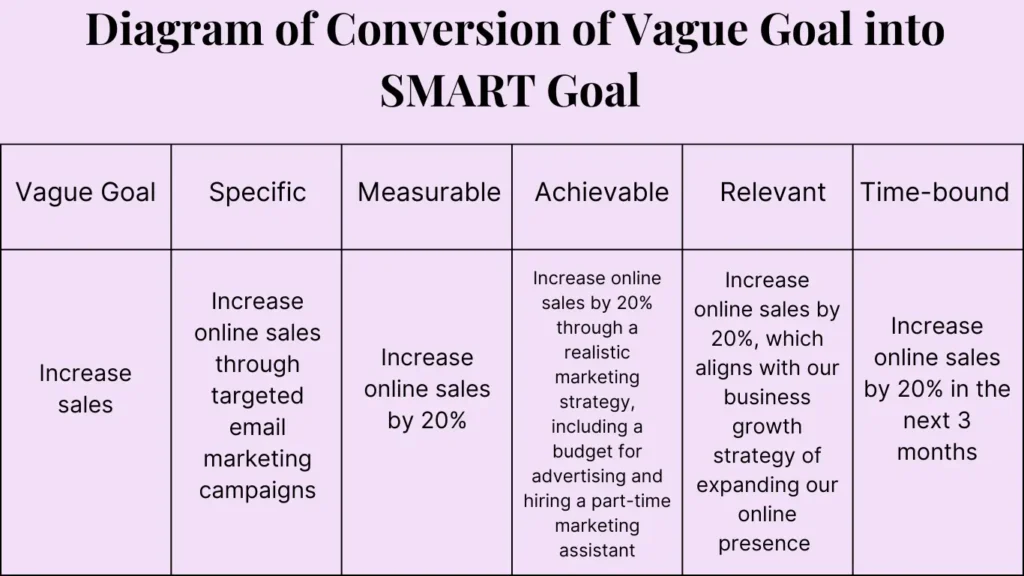Setting goals is a critical part of achieving success, whether in your personal life or in business. However, merely setting goals isn’t enough; they need to be well-defined and attainable. This is where the SMART goal framework comes into play. SMART goals are important because they are designed to provide clarity, direction, and motivation.
In this article, we will explain what SMART goals are and how you can apply this framework to both personal and business goals in detail.
What are SMART Goals?
SMART is an acronym that stands for:
- Specific: Goals should be clear and specific, leaving no room for ambiguity.
- Measurable: Goals need to have criteria for measuring progress and success.
- Achievable: Goals should be realistic and attainable, not impossible to reach.
- Relevant: Goals must be aligned with broader objectives and relevant to your life or business.
- Time-bound: Goals should have a clear deadline or timeframe for completion.

Let’s break down each component of the SMART goals framework in more detail.
Specific
A specific goal answers the questions of who, what, where, when, and why. It narrows your focus and clearly defines what you want to achieve.
Personal Example:
Instead of saying “I want to get fit,” a specific goal would be “I want to lose 10 pounds in 3 months by going to the gym three times a week and following a healthy diet.”
- Who: You
- What: Lose 10 pounds
- Where: At the gym
- When: In 3 months
- Why: To improve health and fitness
Business Example:
Rather than stating “We want to increase sales,” a specific goal would be “We aim to increase our product sales by 20% in the next quarter through targeted marketing campaigns and improved customer service.”
- Who: Your business
- What: Increase product sales by 20%
- Where: In the market
- When: Next quarter
- Why: To boost revenue and market presence
Measurable
A measurable goal provides tangible evidence that you are making progress. It includes criteria to track your achievements and milestones.
- Personal Example: “I will track my weight loss progress by weighing myself every Monday and recording it in a journal.”
- Measurement: Weekly weigh-ins
- Business Example: “We will measure our sales increase by reviewing monthly sales reports and comparing them to the previous quarter.”
- Measurement: Monthly sales reports
Having measurable goals helps you stay on track and celebrate small achievements along the way. It’s important to have quantifiable criteria to know if you are progressing toward your goal.
Achievable
An achievable goal is realistic and attainable, considering your current abilities and resources. It should stretch your abilities but remain possible.
- Personal Example: “I will start by going to the gym twice a week and gradually increase to three times a week.”
- Realistic Step: Starting with twice a week to build a habit
- Business Example: “We will allocate 10% of our budget to marketing and provide additional training to our sales team to achieve the 20% sales increase.”
- Resources: Budget and training for sales team
Setting achievable goals ensures you have the necessary tools and resources to reach your goal without setting yourself up for failure.
Relevant
A relevant goal matters to you and aligns with other relevant goals. It should be worthwhile and meet your needs.
- Personal Example: “Losing weight will improve my overall health and energy levels, which is important for my well-being.”
- Relevance: Improved health and energy levels
- Business Example: “Increasing sales will help us expand our market presence and boost profitability, aligning with our business growth objectives.”
- Relevance: Market expansion and profitability
Relevant goals ensure that your efforts are aligned with broader personal or business objectives, making them more meaningful and motivating.
Time-bound
A time-bound goal has a clear deadline. This helps create a sense of urgency and prompts you to take action.
- Personal Example: “I will achieve my weight loss goal by the end of three months, starting from today.”
- Deadline: Three months
- Business Example: “We will achieve a 20% sales increase by the end of the next quarter.”
- Deadline: Next quarter
Having a deadline creates urgency and helps prioritize tasks to meet the goal within the specified time frame.
Applying SMART Goals to Personal Goals
- Identify Your Goal: Determine what you want to achieve. For instance, improving your fitness level.
- Make it Specific: Define the goal clearly, like losing 10 pounds.
- Ensure it’s Measurable: Decide how you will track progress, such as weekly weigh-ins.
- Check Achievability: Make sure the goal is realistic. Losing 10 pounds in three months is achievable.
- Ensure Relevance: Connect the goal to your broader life objectives, like better health.
- Set a Deadline: Establish a timeframe, such as three months.
Example:
- Goal: Lose 10 pounds in 3 months
- Specific: I want to lose 10 pounds in 3 months by going to the gym three times a week and following a healthy diet.
- Measurable: I will track my weight loss progress by weighing myself every Monday and recording it in a journal.
- Achievable: I will start by going to the gym twice a week and gradually increase to three times a week.
- Relevant: Losing weight will improve my overall health and energy levels.
- Time-bound: I will achieve my weight loss goal by the end of three months.
Applying SMART Goals to Business Goals
- Identify the Business Objective: Decide on a goal, such as increasing sales.
- Make it Specific: Define the goal, like a 20% sales increase.
- Ensure it’s Measurable: Use metrics like monthly sales reports.
- Check Achievability: Allocate resources and set realistic targets.
- Ensure Relevance: Align the goal with overall business growth strategies.
- Set a Deadline: Define a timeframe, such as by the end of the next quarter.
Example:
- Goal: Increase product sales by 20% in the next quarter
- Specific: We aim to increase our product sales by 20% in the next quarter through targeted marketing campaigns and improved customer service.
- Measurable: We will measure our sales increase by reviewing monthly sales reports and comparing them to the previous quarter.
- Achievable: We will allocate 10% of our budget to marketing and provide additional training to our sales team.
- Relevant: Increasing sales will help us expand our market presence and boost profitability.
- Time-bound: We will achieve a 20% sales increase by the end of the next quarter.
In conclusion, the SMART goal framework is a powerful tool for setting and achieving both personal and business goals. By ensuring that your goals are Specific, Measurable, Achievable, Relevant, and Time-bound, you can create a clear path to success.
Whether you’re aiming to improve your health or boost your company’s sales, applying the SMART criteria will help you stay focused, motivated, and on track to achieve your objectives.
Start setting SMART goals today and watch as you make significant progress toward your dreams and ambitions.



